Chandeliers with lampshade
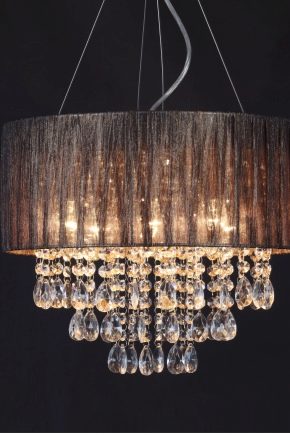
Lighting is an important element in the decor of any room. A chandelier with a lampshade can serve as a source of light, or it can become a central element of the decor and set a style for the room. A properly selected lampshade provides the required amount of light, comfort, and creates a mood.
Peculiarities
Chandeliers with a lampshade are a lighting element with which you can both diffuse light and create a directed beam of light on certain objects. Lampshade chandelier is a chandelier skeleton with the required number of arms according to the number of lamps. Each horn is supplied with a socket and a lamp shade frame or holder for it.
The first chandeliers with lampshades were used most often in the bedroom. To date, design ideas in the design of lampshades are endless, which makes it possible to select the necessary option for a lighting device for any style of interior and functional purpose of the room.

Features of lampshade chandeliers:
- create soft diffused light in the room;
- reduce the amount of shadows from interior items;
- the light of the lampshade softens the contours of interior items;
- depending on the color of the dome, an additional shade is created in the room;
- a variety of forms, materials and techniques of execution allows you to choose the necessary model for any interior;
- easier maintenance of the lamp shade dome thanks to new materials and impregnations;
- safe use of any materials due to the use of energy-saving lamps that do not heat the lamp shade dome;
- it is used for the purpose of zoning a room with the help of light (recreation area and workplace);
- the ability to make yourself from textiles or materials used in the decor of the room.
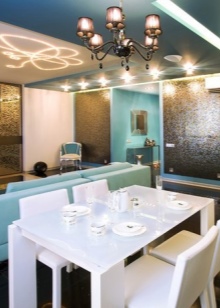
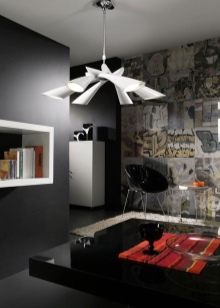
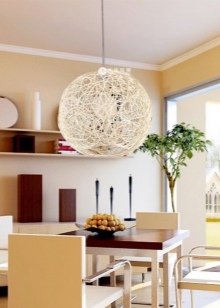
Chandelier models
Lampshade models of chandeliers have many modifications.
By the type of attachment, lampshade chandeliers are divided into:
- ceiling;
- suspended.
Ceiling mounted on a special metal strip to the ceiling. The distance from the ceiling to the light source is minimal. This type is suitable for rooms with a small height and area.
Hanging lampshade chandeliers are mounted on a hook mounted in the ceiling and are a combination of suspensions and branches of the lighting fixture skeleton. The base of such a model can be made of materials of varying rigidity, which statically fix the sockets and lampshades or make it possible to change the angle of illumination. The suspended model can be used in spacious rooms with high ceilings.
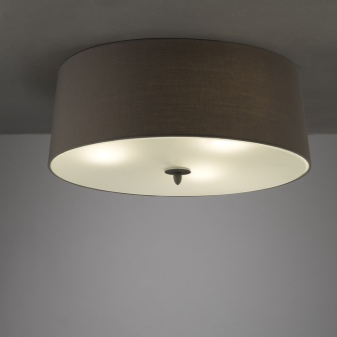
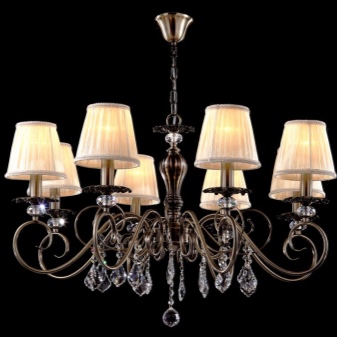
By the number of lighting elements, lampshade chandeliers can be:
- with one lamp;
- with multiple lamps.
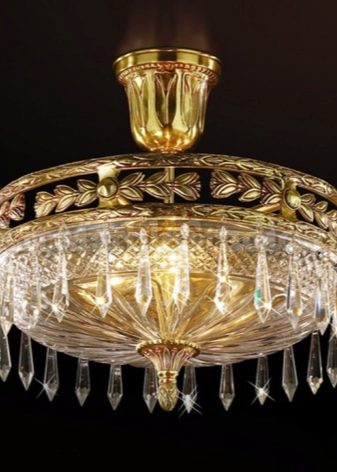
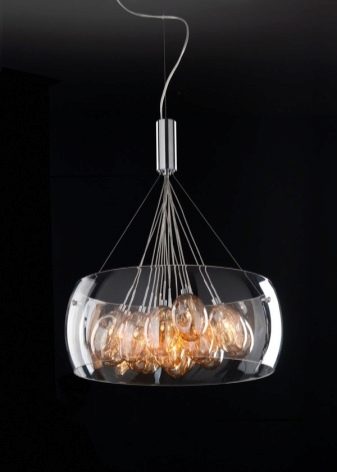
According to the type of use of lamps, models with lamps are distinguished:
- incandescent;
- halogen;
- energy saving;
- LED.
For safety reasons, incandescent lamps should be used in lampshades made of refractory materials.


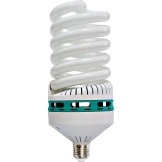

Types of lampshades
In the new collections of lighting fixtures, designers do not miss the opportunity to experiment with shape and material, offering new possibilities for using the lampshade in various styles.
Types by size:
- huge;
- large;
- medium;
- miniature.
Large sizes of lampshades are used in the amount of 1-3 units per chandelier, most often in pendant models with one lamp. Medium and miniature views look original in multi-lamp ceiling and pendant models. These views create cascading and multidirectional lighting views.

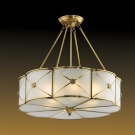
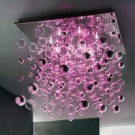
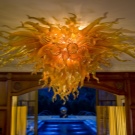

According to the style decision, they are divided into:
- classics;
- retro models;
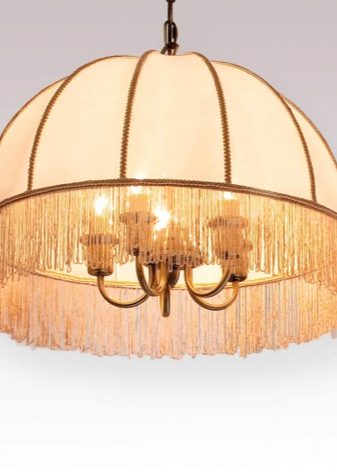
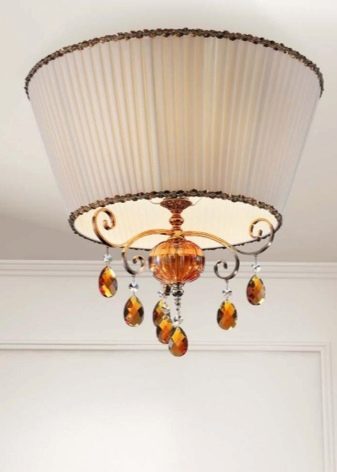
- high tech;
- modern;
- provence;

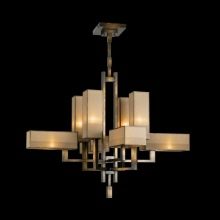
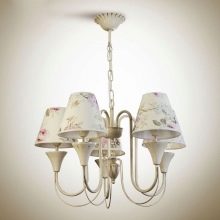
- country;
- loft;
- minimalism;
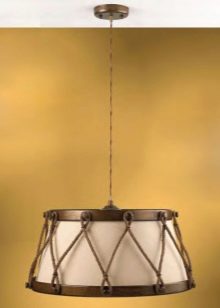

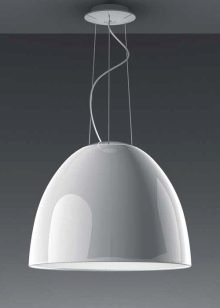
- eco-models;
- baroque;
- Art Deco.
The style of a chandelier with a lampshade should match the overall style of the room.
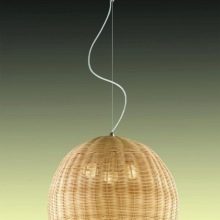
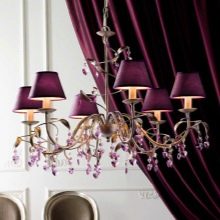
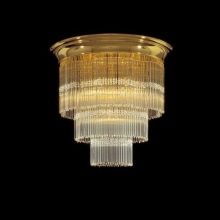
By form, they are divided into models:
- geometric shape (cone, hemisphere, sphere, rectangular, cube, etc.);
- irregular shape.
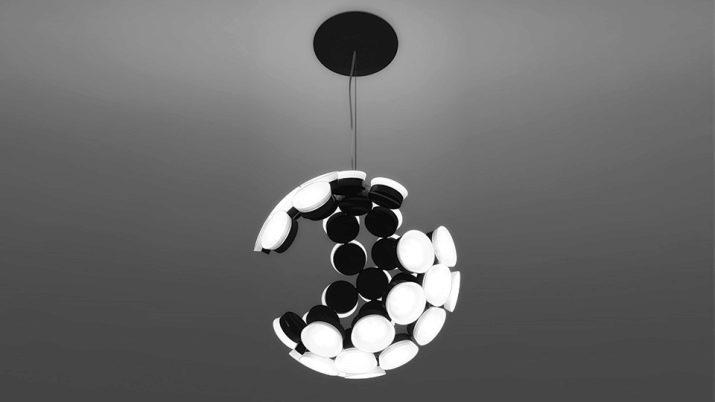
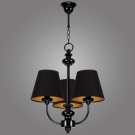

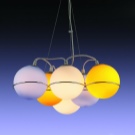
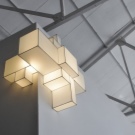
According to the material of manufacture, they are divided into:
- natural (wood, ceramics, straw, etc.);
- glass (glass, crystal);
- plastic;
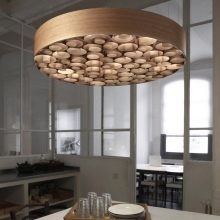
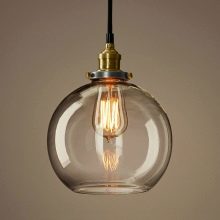
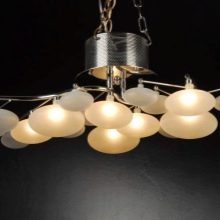
- textile (linen, silk, satin, knitted or crocheted);
- lace;
- paper;
- iron.
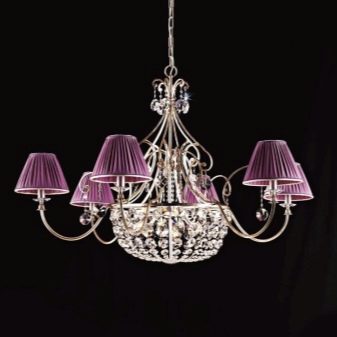
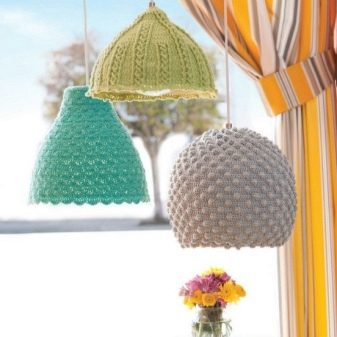
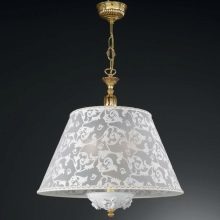
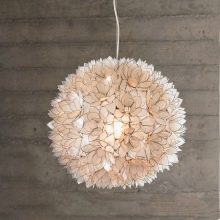

The production of a lampshade from natural materials gives the lighting fixture coziness and warmth. This type is used in residential premises, especially popular in eco-design. Glass lampshades refract the luminous flux of the lamp in different directions, creating a play of light. When sunlight hits, glare is also created, the room is filled with bright rays.
Models of glass lampshade chandeliers are light, soaring. The material is used to create chandeliers of any style. Hand-painted with paints on the dome of the lampshade with ornaments of Gzhel, Khokhloma, elements from the paintings of famous artists is widely used. Plastic is a versatile material that allows you to create a dome of both geometric and irregular shapes, in any color scheme, style and size.
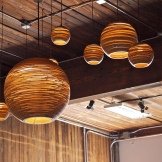

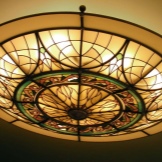
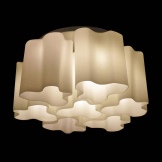
Depending on the choice of textiles, different lighting effects are achieved. Thick satin and linen absorb and soften bright light. Silk, satin, organza let in light and provide bright room lighting in soft colors. Lacy lampshades give intricate highlights and shadow patterns on the walls of the room. Such models look easy and girlishly romantic.
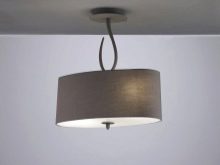
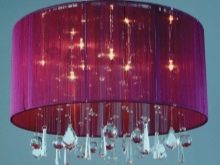
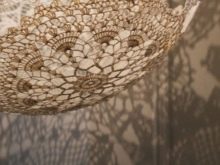
Paper options are often used in modern models to support Japanese or Chinese motives in the interior, in eco-design, in the style of minimalism. Metal lampshades are made of light materials: aluminum, brass, bronze. Metal does not transmit light, so this kind of lighting is used for directional lighting. Metal is a versatile material, so you can find the right model for any style.
Various textures, combinations of colors, patterns and designs on textiles can be used in the materials for the manufacture of the lampshade body.

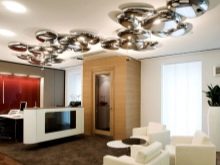
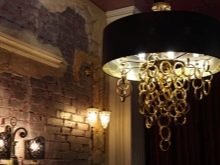
Colors
The color performance of the lampshade lamp has no boundaries and depends on some factors:
- if the lampshade chandelier is the only source of lighting in the room, then the color of the lampshade should match the main color of the interior in gamut and transmit a sufficient amount of light;
- provided that various lighting options are used, including a lampshade chandelier, the color of the lampshade can contrast with the color scheme of the room.
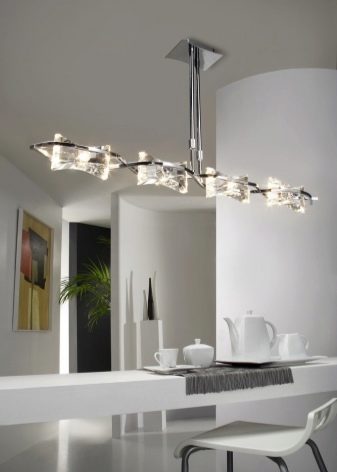
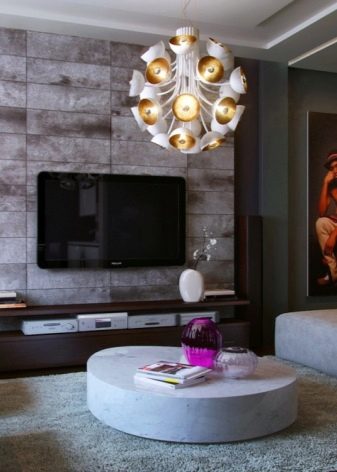
Saturated colors and their shades (blue, purple, green, brown, black) are suitable for bedrooms, relaxation areas in a large space, lounge areas. These colors absorb excessive brightness, scatter light, soften interior items, and allow you to relax and unwind.
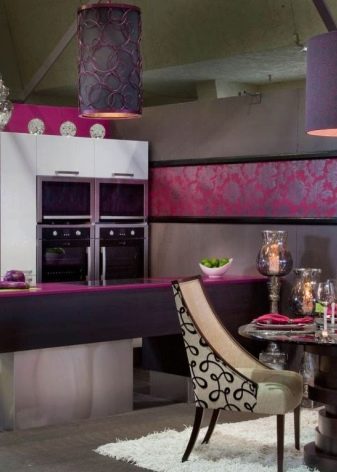
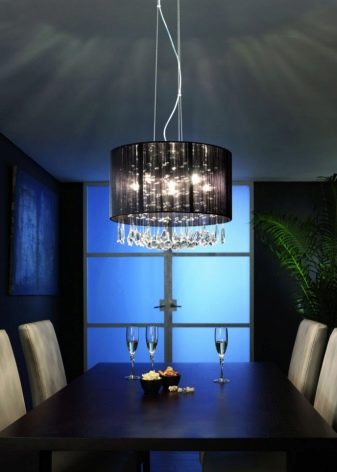
Blue, lilac, orange, pink, beige, white colors will become an organic element of the interior, made in the specified colors. These lampshades will retain bright lighting by slightly softening the direct light output from the lamps.
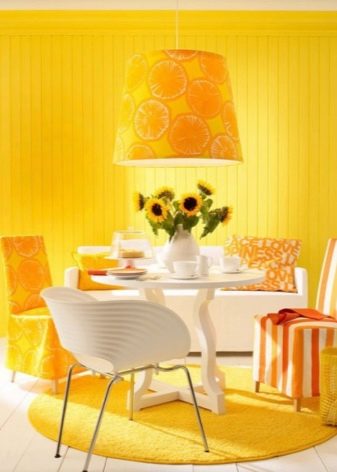
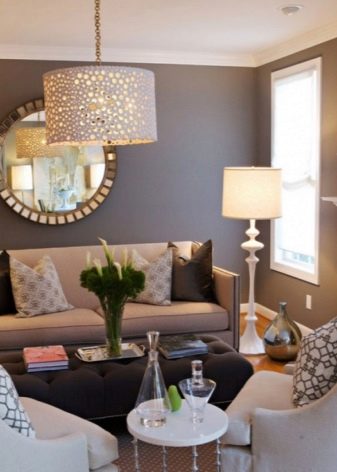
Accommodation options in the interior
The variety of shapes and models of lampshade chandeliers allows you to use this type of lighting in a room for any purpose.
For non-residential areas where people work, the lighting should be bright and keep the eyes healthy. As a rule, in the office interior decoration, a chandelier with a lampshade plays the role of a bright element, the main task of which is to attract attention, to add variety to the gray everyday life. In such a room, the chandelier will be an additional source of light or even serve as a decorative element.
Also, a chandelier with a lampshade in a non-residential area will allow you to separate the rest area. By dimming and diffusing light, the lampshade creates a comfortable atmosphere for recuperation without leaving the office.
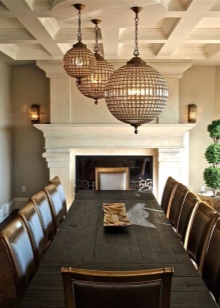

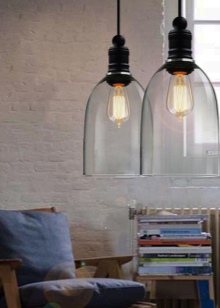
Various models and style solutions of lampshades are widely used in catering establishments (cafes, restaurants), places of recreation (nightclubs). Textured materials, unusual colors, irregular shapes of the lampshade dome will decorate such rooms and give them individuality.

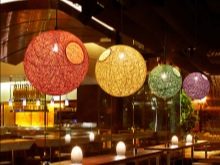
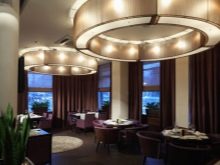
In non-residential premises for special events, the chandelier is the central element of the decor. In meeting rooms, ceremonial halls, classic cascade chandeliers with lampshades made of glass, crystal, with additional decor of the chandelier skeleton with Swarovski crystals and glass beads are used.
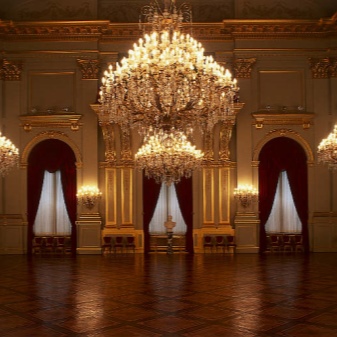
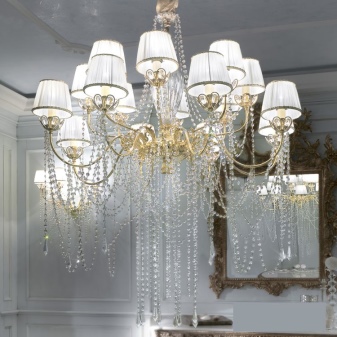
In living quarters, a lampshade chandelier has traditionally been used in the bedroom. Designers recommend making the dome of the lampshade from the same textiles as on the windows or in the decoration of the room. Textile lampshades are favorites of bedrooms, but materials such as wood, rattan, plastic, and less often metal are also widely used.
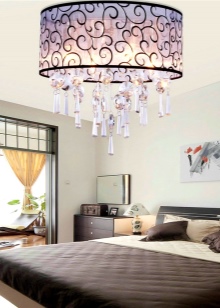
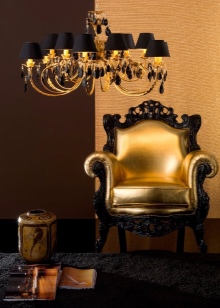
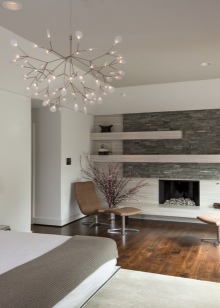
In the kitchen, a lampshade chandelier separates the dining area from the work area. As a rule, pendant chandeliers with lampshades made of plastic, metal, ceramics are used. These materials are easy to maintain.
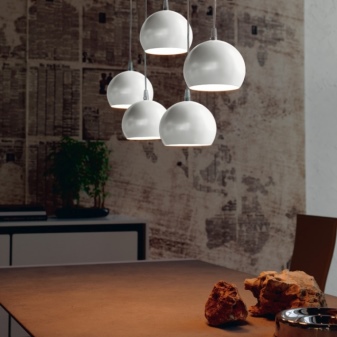
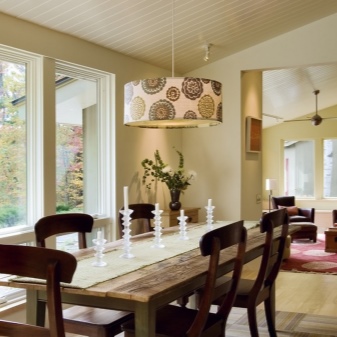
There are no limits for imagination on the use of lampshade chandeliers in the living room. The main thing is that the style of the lamp should correspond to the style of the room, be a bright, contrasting accent in color, or differ by several tones from the color of the walls. Designers suggest experimenting: they attach ceiling chandeliers to the wall, choosing interesting patterns and colors of the lampshade dome.

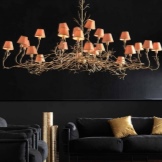
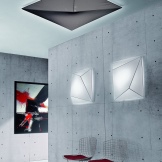
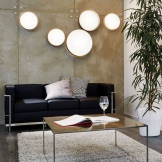
The following video will show you many original kitchen chandeliers and more.













The comment was sent successfully.